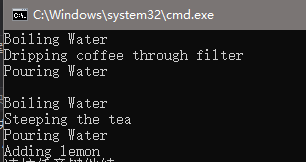模版方法模式(Template Method Pattern)定义了一个算法的操作步骤,但其中的某些步骤需要派生来对应实现。
例如我们需要准备咖啡和茶,准备咖啡基本步骤为烧开水,加入咖啡粉,将咖啡倒入杯子,增加牛奶或糖(可选),准备茶的基本步骤为烧开水,加入茶粉,将茶倒入杯子,增加柠檬(可选)。我们发现在制作两个饮料的过程中,烧开水和倒入杯子这两个步骤是一样的,剩下的两个步骤,向烧开的水中增加相应的粉和增加配料,这两部分也是类似的,于是我们可以用模版方法模式,将这两步骤作为抽象方法。
代码示例
算法模版基类
咖啡因饮料模版1
2
3
4
5
6
7
8
9
10
11
12
13
14
15
16
17
18
19
20
21
22
23
24
25
26
27
28
29
30
| public abstract class CaffeineBeverage
{
public void PrepareRecipe()
{
boilWater();
brew();
pourInCup();
if (NeedCondiments())
addCondiments();
}
protected abstract void brew();
protected abstract void addCondiments();
private void boilWater()
{
Console.WriteLine("Boiling Water");
}
private void pourInCup()
{
Console.WriteLine("Pouring Water");
}
public virtual bool NeedCondiments()
{
return true;
}
}
|
例子中brew和addCondiments即为模版函数,而NeedCondiments这种提供了基本实现,但派生类中仍然可以重写的函数被称为钩子(Hook)。
咖啡因饮料实现
咖啡1
2
3
4
5
6
7
8
9
10
11
12
13
14
15
16
17
| public class Coffee : CaffeineBeverage
{
protected override void addCondiments()
{
Console.WriteLine("Add sugar and Milk");
}
protected override void brew()
{
Console.WriteLine("Dripping coffee through filter");
}
public override bool NeedCondiments()
{
return false;
}
}
|
茶1
2
3
4
5
6
7
8
9
10
11
12
| class Tea : CaffeineBeverage
{
protected override void addCondiments()
{
Console.WriteLine("Adding lemon");
}
protected override void brew()
{
Console.WriteLine("Steeping the tea");
}
}
|
测试代码及结果
测试代码1
2
3
4
5
| Coffee coffee = new Coffee();
Tea tea = new Tea();
coffee.PrepareRecipe();
Console.WriteLine();
tea.PrepareRecipe();
|
运行结果:



